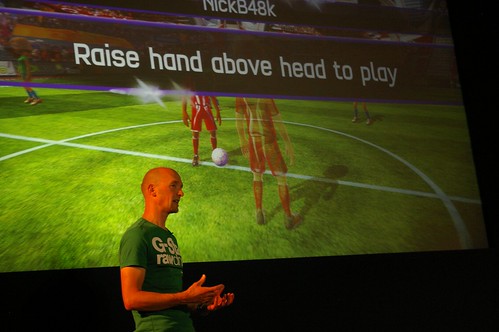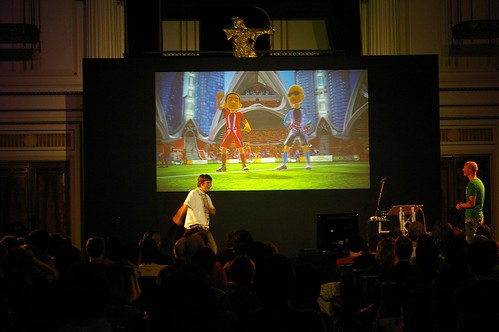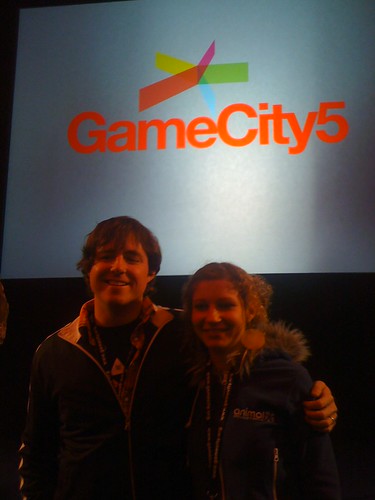The subject of new Microsoft hardware brings me to the afternoon session, in which Nick Burton (Executive Producer of Technology and Communications) demonstrates Kinect Sports and discusses some of Kinect's potential.
I have to say up-front that huge question marks still hang over the viability of Kinect in my own mind. In spite of Nick's assertion that Kinect can allow for coffee tables obscuring feet and smaller living spaces, by their own admission Rare re-modelled their entire office space from cubicles to open plan in order to make working on Kinect more feasible. The stage used for the presentation was enormous and I wonder how many people live in homes in which the Kinect will work (especially given the casual market Microsoft are targeting with this product).
I have to say up-front that huge question marks still hang over the viability of Kinect in my own mind. In spite of Nick's assertion that Kinect can allow for coffee tables obscuring feet and smaller living spaces, by their own admission Rare re-modelled their entire office space from cubicles to open plan in order to make working on Kinect more feasible. The stage used for the presentation was enormous and I wonder how many people live in homes in which the Kinect will work (especially given the casual market Microsoft are targeting with this product).
Nick introduces the Sports package with enthusiasm and it is clear that some considerable though has gone into translating these sports into meaningful actions. Football is distilled into a series of passing choices across the field culminating in a final shot at the goal. Discus seems intuitive and even javelin affords the player a convincing run-up and launch.
What is immediately apparent however is that there are two unexpected and fascinating emergent behaviours created by Kinect's approach. The first nice touch is that, because Kinect is capable of tracking multiple individuals, you have to raise your hand at the beginning of each game to indicate that you wish to take part. This is a lovely child-like form of interaction that will have most people giggling the first time they play.
The second and more important emergent element that comes out of Kinect's continuous tracking is that ALL of your body motion is mapped to the player avatar. It's immediately obvious, now that you see a motion-captured avatar standing next to the AI figures just how different and distinct human movement is. Witnessing a game character slouch, or favour balancing weight on one leg or brushing a spec from clothing is all reproduced by the game system. This leads on to an important emergent behaviour:playing with and showing off through the avatar. All the players who took part in the Kinect demonstration instinctively put their avatars through victory celebrations after scoring, through arms in the air, dancing and air guitaring (no pelvic thrusts though, in spite of the amount of 3rd person shooters that offer this as a victory salute). In fact it became more noticeable when players wanted to make their characters display behaviour at a time when the game didn't seem to want to track their actions. This may lead to developers forcing games to map player movement to avatars at all times.
What is immediately apparent however is that there are two unexpected and fascinating emergent behaviours created by Kinect's approach. The first nice touch is that, because Kinect is capable of tracking multiple individuals, you have to raise your hand at the beginning of each game to indicate that you wish to take part. This is a lovely child-like form of interaction that will have most people giggling the first time they play.
The second and more important emergent element that comes out of Kinect's continuous tracking is that ALL of your body motion is mapped to the player avatar. It's immediately obvious, now that you see a motion-captured avatar standing next to the AI figures just how different and distinct human movement is. Witnessing a game character slouch, or favour balancing weight on one leg or brushing a spec from clothing is all reproduced by the game system. This leads on to an important emergent behaviour:playing with and showing off through the avatar. All the players who took part in the Kinect demonstration instinctively put their avatars through victory celebrations after scoring, through arms in the air, dancing and air guitaring (no pelvic thrusts though, in spite of the amount of 3rd person shooters that offer this as a victory salute). In fact it became more noticeable when players wanted to make their characters display behaviour at a time when the game didn't seem to want to track their actions. This may lead to developers forcing games to map player movement to avatars at all times.
I did ask Nick Burton about how this very different control system might inform new kinds of game and new interactions within games rather than sports or other more traditional/existing genres. He was fairly reluctant to share many of Rare's prototype ideas, as you can imagine, but he did insist that a lot of crazy suggestions had been put forward and even prototyped. He discussed a kind of alternative reality, because the Kinect camera makes a 3D model of your living space and is more than capable of identifying individual objects like sofas, tables etc and can even render your space with different lighting, as the base lighting can be derived from the image. He talked about ideas like turning the floor of your room to lava, forcing players to climb on an available seat.
He also talked about Kinect "enhanced" features which support traditional gaming more readily. The instinctive tilt of the head when steering a racing game or peering around a corner in an FPS can now be read by Kinect and fed into the game. Combined with voice recognition there is a good potential for Kinect to provide supporting functionality for games, freeing-up the primary controller for main actions.
In summary, Kinect represents a remarkable piece of technology, implemented very simply and transparently. It's undeniable the potential is there for some remarkable changes in gaming, but my personal opinion is that it is in danger of a cautious market and difficult local (environment) conditions which may cause it to fall into the sports and casual market to which the Wii has largely succumbed.
Also, because of the need to keep looking at the screen, actions such as turning or looking around have to be faked, which is counter intuitive.
For me, if you could combine the body tracking of Kinect with a decent VR headset... now there's a killer app! Given that Kinect has a flawless understanding of your position in 3D space, imagine being able to view a 3D immersive scene and reach out to grab an in-game item. In short I still feel that Kinect combined with a fixed screen is a dead end. The workarounds that have to be achieved as a results of needing to keep facing the display screen are obvious with almost every gesture. Combine this with my already negative views on 3D TV (how can it be 3D when the scene is bounded by the frame of the screen?) However it does give clues about a future path to more immersive gameplay. Now I just need to install the Jamiroquai moving floor so I can walk around while remaining still...
After this session, my GameCity became about connecting for real with some people I've only ever met digitally. I met some of the lovely folks from Game People and found a huge amount of common heritage (always nice to meet other people who spent the 90's cherishing the Amiga!) and also got to meet Rebecca Mayes after her marathon 8-hour game creating session with Adam Saltsman. It was nice to be there to see the culmination of their efforts as it happened and witness the unveiling!
He also talked about Kinect "enhanced" features which support traditional gaming more readily. The instinctive tilt of the head when steering a racing game or peering around a corner in an FPS can now be read by Kinect and fed into the game. Combined with voice recognition there is a good potential for Kinect to provide supporting functionality for games, freeing-up the primary controller for main actions.
In summary, Kinect represents a remarkable piece of technology, implemented very simply and transparently. It's undeniable the potential is there for some remarkable changes in gaming, but my personal opinion is that it is in danger of a cautious market and difficult local (environment) conditions which may cause it to fall into the sports and casual market to which the Wii has largely succumbed.
Also, because of the need to keep looking at the screen, actions such as turning or looking around have to be faked, which is counter intuitive.
For me, if you could combine the body tracking of Kinect with a decent VR headset... now there's a killer app! Given that Kinect has a flawless understanding of your position in 3D space, imagine being able to view a 3D immersive scene and reach out to grab an in-game item. In short I still feel that Kinect combined with a fixed screen is a dead end. The workarounds that have to be achieved as a results of needing to keep facing the display screen are obvious with almost every gesture. Combine this with my already negative views on 3D TV (how can it be 3D when the scene is bounded by the frame of the screen?) However it does give clues about a future path to more immersive gameplay. Now I just need to install the Jamiroquai moving floor so I can walk around while remaining still...
After this session, my GameCity became about connecting for real with some people I've only ever met digitally. I met some of the lovely folks from Game People and found a huge amount of common heritage (always nice to meet other people who spent the 90's cherishing the Amiga!) and also got to meet Rebecca Mayes after her marathon 8-hour game creating session with Adam Saltsman. It was nice to be there to see the culmination of their efforts as it happened and witness the unveiling!



No comments:
Post a Comment